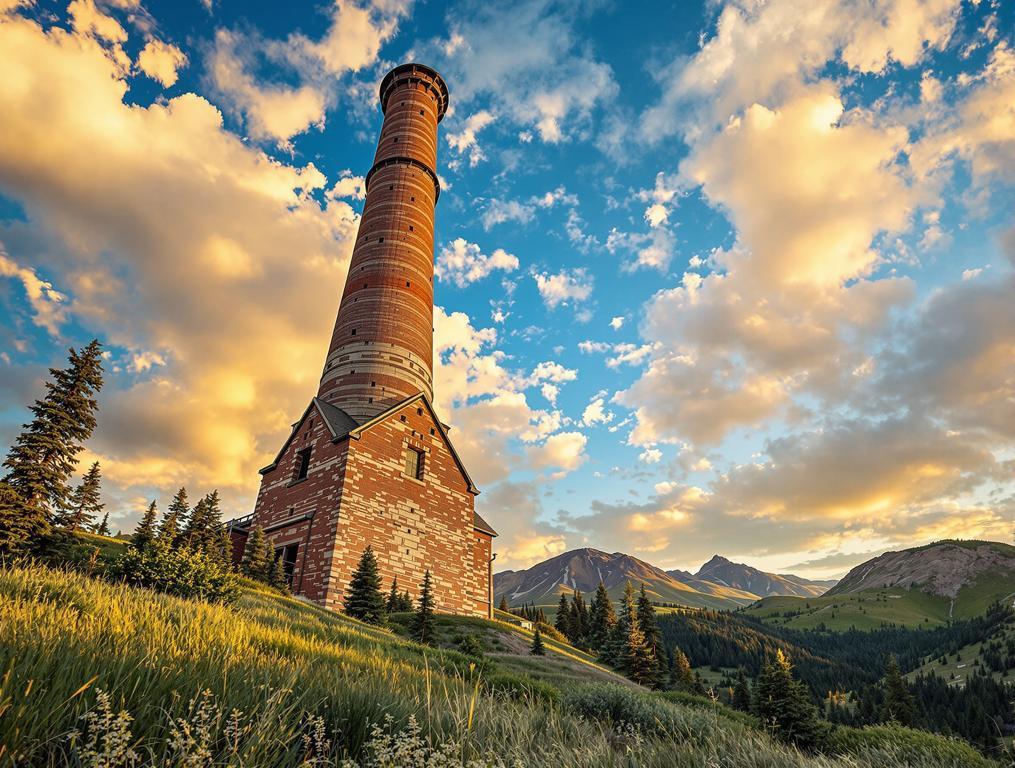The 585-foot brick chimney rises like a sentinel against Montana’s brilliant blue July sky, visible from nearly every angle in Anaconda. Stepping from my car onto Main Street, I’m struck by the immediate contrast: a town of fewer than 10,000 residents living in the shadow of what was once the world’s tallest free-standing brick structure. It’s my first time in this former copper smelting hub, precisely 26 miles northwest of Butte and almost perfectly positioned between Glacier and Yellowstone National Parks.
What most summer travelers racing between Montana’s famous parks don’t realize is that they’re bypassing America’s most remarkable industrial-to-wilderness transformation story. The thermometer reads 78 degrees as locals gather for Anaconda’s Thursday Community Market — yet we’re just 8 miles from alpine hiking trails that remain blissfully uncrowded.
The 585-foot Sentinel Watching Over America’s Industrial Past
The Anaconda Smelter Stack stands as a monument to America’s copper empire, constructed in 1919 when the town processed 1/6 of the world’s copper. Today, this National Historic Landmark towers over a landscape that’s undergone an environmental renaissance.
Unlike the abandoned factories of the Rust Belt, Anaconda has transformed its industrial footprint. The Old Works Golf Course incorporates black slag bunkers from former smelting operations — the only place in America where you can golf on the remnants of industrial waste, now perfectly safe after extensive remediation.
What’s remarkable about summer 2025 is the completion of several major environmental restoration projects that have been decades in the making. The remediated landscape now supports wildlife that was absent for generations.
“I’ve watched this place change from a toxic wasteland to somewhere I bring my grandchildren to spot eagles and deer. Never thought I’d see the day when people would visit Anaconda for its natural beauty rather than jobs.”
From Copper Giant to Environmental Success Story
While Aspen and Jackson Hole overflow with summer tourists, Anaconda offers breathing room. The Pintler Scenic Byway winds through mountain terrain that rivals Colorado’s spectacular July wildflower season without the traffic jams.
Unlike neighboring Butte (population 34,000+), Anaconda maintains a more intimate scale. Downtown’s preserved Victorian and Classical Revival buildings house locally-owned shops where owners still remember your name.
Smelter City Brewing captures this transformation perfectly, creating craft beers like “Stack 585 IPA” in a family-friendly setting. Like Virginia’s craft brewing traditions, Anaconda’s brewery infuses local history into each carefully crafted pint.
The summer-only access to higher elevation trails means July-August 2025 provides the perfect window to witness nature’s reclamation. Georgetown Lake’s crystal waters reflect mountain peaks where bighorn sheep now roam terrain once clouded by smelter smoke.
Summer 2025: Perfect Timing to Witness Nature’s Reclamation
What makes this summer particularly significant is the debut of Montana’s longest zipline course, featuring seven lines spanning up to 2,100 feet through a forest once devoid of wildlife. The surrounding Pintler Mountains offer solitude similar to Nevada’s mountain wilderness, providing breathtaking vistas without battling tourist crowds.
Lost Creek State Park’s 50-foot waterfall cascades through pink granite canyons just minutes from town. Morning hikers often spot mountain goats navigating the limestone cliffs above – a testament to the area’s environmental comeback.
Anaconda’s economic revival through outdoor recreation demonstrates how rural economic transformation can breathe new life into former industrial centers. The Thursday Community Market runs July through September, featuring local artisans and farm-fresh produce.
Practical Guide: Exploring Anaconda’s Industrial-Natural Wonders
For the best experience, arrive via Montana Highway 1 (the Pintler Scenic Byway) rather than Interstate 90. Park downtown where spots remain free and plentiful, unlike Montana’s tourist hotspots.
The Washoe Theater offers $6 movie tickets in a 1930s Art Deco setting that would cost triple in larger cities. For sweeping views, take the Old Works Trail at sunset when the stack casts a dramatic shadow across the valley.
Stay at Fairmont Hot Springs Resort ($159/night) where geothermal pools invite soaking after hiking the nearby Continental Divide Trail segment that passes just south of town.
As I drive away, the stack remains visible in my rearview mirror for miles – like America’s industrial past keeping watch over its environmental future. I can’t help but feel I’ve witnessed something special: a place where our nation’s manufacturing might is being reconciled with wild Montana beauty. The real treasure of Anaconda isn’t just what it was, but what it’s becoming – right now, this summer, as nature reclaims what was once surrendered to industry.
